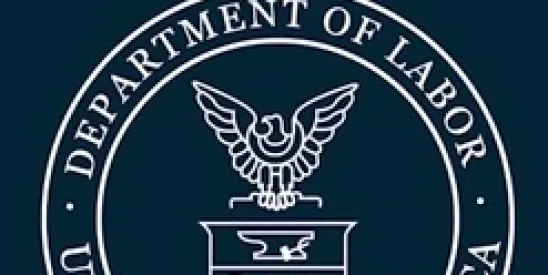This alert is the second in a series. In our first alert, “History and State of Play,” our global financial services policy team described the status of the Department of Labor’s (DOL) proposed rule on socially responsible investing, “Financial Factors in Selecting Investments” (Proposed Rule).1 In this Alert, our ERISA fiduciary team describes the Proposed Rule’s implications, if finalized in its current form, for plan sponsors and investment managers that would like to consider environmental, social, and governance (ESG) factors when evaluating investments.
ESG-themed funds and investment strategies have attracted tens of billions of dollars in recent years. However, U.S. retirement plan sponsors and other fiduciaries of private-sector retirement assets that would like to consider ESG factors when making investment decisions must consider the U.S. federal pension statute, the Employee Retirement Income Security Act of 1974, as amended (ERISA). ERISA imposes strict investment duties on fiduciaries responsible for investing private-sector pension plan assets, including fiduciaries with responsibility for selecting and monitoring investment options for 401(k) and other individual account retirement plans.
ERISA’s fiduciary duties include a requirement that fiduciaries act solely in the interest of the plan’s participants and beneficiaries and for the exclusive purpose of providing benefits to the participants and beneficiaries and defraying reasonable expenses of administering the plan.2 The duty of loyalty requires ERISA fiduciaries to act with a single-minded focus in the interest of plan participants and beneficiaries. ERISA’s duty of prudence has been interpreted to prevent an ERISA fiduciary from choosing an investment that is financially less beneficial than an available alternative. These fiduciary standards are the same no matter the investment category. This legal framework presents challenges for plan sponsors and investment managers that seek to consider ESG factors when investing ERISA assets or offering investment options for 401(k) plan participants.3
Prior DOL Guidance
Over the years, the DOL has been asked to consider the application of ERISA’s fiduciary rules to ESG investing. DOL guidance has not been entirely consistent and seems to vary based on whether there is a Democratic or Republican administration at the time the guidance is issued. However, a consistent theme runs across the DOL’s guidance, including the Proposed Rule: When making investment decisions, ERISA fiduciaries must focus solely on the plan’s financial risks and returns.
In 1994 guidance, the DOL stated that ESG investing is not inherently incompatible with ERISA’s fiduciary obligations.4 The DOL explained that ERISA fiduciaries could consider ESG factors as “tie-breakers,” that is, if an ESG investment has the same expected return and risk characteristics as an investment that does not consider ESG factors, a fiduciary may select the ESG investment consistent with its fiduciary duties.
In 2008, the DOL replaced the 1994 guidance with Interpretive Bulletin 2008-01. There, the DOL directed that a fiduciary should “consider only factors that relate to the economic interest of participants and their beneficiaries in plan assets, and shall not use an investment policy to promote myriad public policy preferences.”5
In 2015, the pendulum swung the other way. In Interpretive Bulletin 2015-01 the DOL acknowledged that in some cases ESG factors may have a direct relationship to the economic and financial value of a plan’s investment. In such instances, the DOL stated that ESG factors are not merely “tie-breakers,” but rather are “proper components of the fiduciary’s primary analysis of the economic merits of competing investment choices.”6
In 2018, the DOL “clarified” that its prior guidance merely recognized that there could be instances when ESG issues present material business risk or opportunities for issuers that investment professionals would treat as economic considerations under generally accepted investment theories.7 In such situations, the issues are themselves appropriate considerations and should be considered by a prudent fiduciary along with other relevant economic factors to evaluate investment risk and return profiles. The DOL cautioned however, that fiduciaries “must not too readily treat ESG factors as economically relevant to the particular investment choices at issue when making an investment decision.”
Proposed Rule
In the preamble to the Proposed Rule (Preamble), the DOL described a “lack of precision and rigor” in the ESG marketplace and expressed concern that some investment products may be marketed to ERISA fiduciaries on the basis of purported benefits and goals unrelated to financial performance. The staff of the Securities and Exchange Commission (SEC) has also expressed concern regarding investment products marketed as promoting sustainable or responsible investing. Current SEC examination priorities include the accuracy and adequacy of disclosures provided by registered investment advisers offering clients new types or emerging investment strategies, such as strategies that incorporate ESG factors.8 The SEC is also soliciting public comment on the appropriate treatment for investment funds that use terms such as “ESG” in their name and whether these terms are likely to mislead investors.9 Against this backdrop, the DOL stated that the purpose of the Proposed Rule is to establish a regulatory structure to assist ERISA fiduciaries in separating the “legitimate use of risk-return factors from inappropriate investments that sacrifice investment returns, increase costs, or assume additional risk to promote non-pecuniary benefits or objectives.”
The Proposed Rule would amend the DOL’s investment duties regulation10 under Title I of ERISA to confirm that ERISA requires plan fiduciaries to select investments based solely on financial considerations relevant to the risk-adjusted economic value of a particular investment. The Proposed Rule elaborates on the core principles set forth in ERISA and the current investment duties regulation by adding a requirement that appropriate consideration of an investment includes comparing available investments with regard to diversification, liquidity, and potential risk and return. These are not necessarily the only factors that need to be considered but are used to emphasize that, in comparing investments, fiduciaries must not let nonpecuniary considerations draw them away from an alternative option that is expected to provide better financial results for plan beneficiaries.
The Proposed Rule would add a requirement to regulations under ERISA section 404(a) that, in order for a fiduciary to meet ERISA’s loyalty and prudence requirements, the fiduciary’s investment decisions must be based solely on pecuniary factors and the fiduciary may not subordinate the interests of participants or beneficiaries to the fiduciary’s or another’s interests. The Proposed Rule explains that, for both defined benefit and defined contribution plans, ESG factors and other similar considerations may be economic considerations but only if they present economic risks or opportunities under generally accepted investment theories. The Proposed Rule emphasizes that these factors, if determined to be pecuniary, must be considered alongside other relevant economic factors to evaluate the risk and return profiles of available investments. The weight given to pecuniary ESG factors should reflect a prudent assessment of their impact on risk and return—that is, they cannot be disproportionately weighted.
As discussed above, prior DOL guidance provided that fiduciaries may use nonpecuniary factors as “tie-breakers.” The Proposed Rule would continue to allow nonpecuniary factors to serve as “tie-breakers” for economically indistinguishable alternative investments, but in the Preamble, the DOL stated that it expects ties to “rarely, if ever, occur.” The DOL explained:
To be sure, there are highly correlated investments and otherwise very similar ones. Seldom, however, will an ERISA fiduciary consider two investment funds, looking only at objective measures, and find the same target risk-return profile or benchmark, the same fee structure, the same performance history, same investment strategy, by a different underlying asset composition. Even then, moreover, those two alternatives would remain two different investments that may function differently in the overall context of the fund portfolio, and which going forward may perform differently based on external economic trends and developments.
To safeguard against the risk that fiduciaries will improperly find economic equivalence and make decisions based on nonpecuniary factors without a proper analysis and evaluation, the Proposed Rule requires fiduciaries to document the extent to which ESG factors are used as “tie-breakers,” including why the investments were determined to be indistinguishable and why the selected investment was chosen. The DOL specifically requested comments on this issue, including whether “ties” truly exist and how fiduciaries may appropriately break ties.
The Proposed Rule also includes specific guidance for fiduciaries of individual account plans, such as 401(k) plans, as described below.
Implications for All Plan Sponsors
Plan sponsors and other responsible plan fiduciaries, such as investment committees, should already be taking steps to comply with current DOL guidance on the consideration of ESG factors, but they may need to take additional action if the Proposed Rule is finalized as proposed. Plan fiduciaries would need to ensure, for example, that investment policy statements do not have a different investment selection or monitoring process for ESG investments than the process for investments that do not consider ESG factors.
Plan sponsors and other responsible fiduciaries also have a responsibility to monitor their consultants and advisers, including those with discretion to invest plan assets or select a plan’s investment options, such as investment managers and “outsourced chief investment officers.” The monitoring process may need to be refined so that the responsible fiduciary can ensure that the plan’s manager or consultant is applying a consistent investment process across all types of plan investments.
In addition, when hiring an investment manager or consultant, as part of the due diligence process, the responsible fiduciary would need to evaluate whether the chosen provider operates consistently with the final version of the Proposed Rule. Larger plans often solicit RFPs from potential service providers. If a plan uses a model RFP for vetting service providers or hires a firm to run an RFP process, the responsible plan fiduciary may seek to include questions in the RFP designed to elicit whether the investment advisory or other service providers comply with the final version of the Proposed Rule.
ESG investments currently offered to (or held by) ERISA plans may not be consistent with the principles articulated in a final rule. For example, investment funds characterized as “sustainable” or “impact-driven” investments often disclose purported benefits and goals unrelated to financial performance for fund investors. The plan fiduciary reviewing an investment fund’s documentation as part of the due diligence process should consider these disclosures when deciding whether an investment in the fund is consistent with the final rule.
Thus, responsible fiduciaries for all types of ERISA plans should consider reviewing the plan’s (a) governing documents; (b) investment policy statement; (c) contracts with consultants, managers, and advisers; (d) process for monitoring and hiring such service providers; (e) process for selecting and monitoring investments or plan investment options; and (f) disclosures and practices of current ESG investments to ensure they are consistent with the final version of the Proposed Rule.
Implicaitons for Defined Contribution Plan Fiduciaries
The Proposed Rule also includes specific guidance for fiduciaries of individual account plans, such as 401(k) plans, which are described below. 11
Defined Contribution Plan Investment Options.
Typically, 401(k) plans and other defined contribution plans offer plan participants a menu of investment options, and plan participants can select the portfolio of funds that best suits their needs. An addition to a plan’s investment lineup of a prudently selected investment alternative (other than a default investment alternative, as described below) that includes one or more ESG assessments or judgments in its investment mandate or that includes these parameters in the fund name would not violate ERISA under the Proposed Rule, provided the fiduciary uses only objective risk-return criteria in selecting and monitoring the investment. These criteria may include: (a) benchmarks, (b) expense ratios, (c) fund size, (d) long-term investment returns, (e) volatility measures, (f) investment manager investment philosophy and experience, and (g) mix of asset types. The fiduciary would also need to document its selection and monitoring of the investment in accordance with these principles. If the Proposed Rule is finalized as proposed, the responsible fiduciary should ensure its policies and procedures are consistent with these requirements.
Defined Contribution Plan Default Investments.
To encourage greater retirement savings, many plans automatically enroll eligible workers in the plan, unless workers affirmatively opt out. Automatic enrollment typically diverts funds into a default investment option, which is usually structured to conform to the DOL’s regulation on “qualified default investment alternatives” (QDIAs). If the QDIA regulation is complied with, the responsible plan fiduciary has some limited protection from fiduciary liability with respect to these default investments.
The DOL states in the Preamble that it does not believe that investment funds whose objectives include nonpecuniary goals—even if selected by fiduciaries only on the basis of objective risk-return criteria consistent with the Proposed Rule’s requirements—should be a default investment option in a defined contribution plan:
ERISA is a statute whose overriding concern … has always been providing a secure retirement for American workers and retirees, and it is inappropriate for participants to be defaulted into a retirement savings fund with other objectives absent their affirmative decision. Furthermore, in the QDIA context, a fiduciary’s decision to favor a particular environmental, social, corporate governance, or similarly oriented investment preference—and especially a decision to favor the fiduciary’s own personal policy preferences—would raise questions about the fiduciary’s compliance with ERISA’s duty of loyalty.12
Therefore, if the Proposed Rule is finalized as proposed, plan sponsors or other responsible fiduciaries not only may not be able to use an ESG-themed fund as the default investment option or QDIA, but they may not be able to include ESG investments as components of the plan’s default investment. This is of key importance for plans that use target date funds as their QDIA(s), which are commonly structured as funds of funds.13 Under the Proposed Rule, the responsible fiduciary or its adviser may need to review the default investment’s underlying funds to determine that none are ESG investments. The underlying investments of some target date funds are the plan’s core investment options. If the core investment options include ESG-themed funds, target date funds constructed in this manner may need to be reconsidered.
Implications for Investment Managers
Investment managers that would like to access the large and growing retirement plan market with ESG investment products and services should be familiar both with current ESG guidance from the DOL and with the Proposed Rule.14 If the rule is finalized as proposed, investment managers may need to take actions to comply with the final rule (if the manager is managing ERISA plan assets) and reconsider their product design and marketing strategies to enable plan sponsors or other responsible plan fiduciaries to use the investment manager’s products and services without violating the rule.
Investment managers that manage separate accounts for ERISA assets are subject to the fiduciary responsibility standards described above. Managers of investment funds in which ERISA assets invest may, in certain circumstances, also be subject to ERISA’s fiduciary responsibility provisions, including a final ESG rule.15 These managers should review their investment process and disclosures to ensure consistency with a final rule. Some managers, for example, are signatories of the United Nations-backed Principles for Responsible Investment. Signatories promote the following principles:
(a) we will incorporate ESG issues into investment analysis and decision-making processes, (b) we will be active owners and incorporate ESG issues into our ownership policies and practices, (c) we will seek appropriate disclosure on ESG issues by the entities in which we invest, (d) we will promote acceptance and implementation of the principles within the investment industry, (e) we will work together to enhance our effectiveness in implementing the principles and (f) we will each report on our activities and progress towards implementing the principles.
Investor disclosures may need to be written in a way that indicates that the investment manager will adhere to these principles, subject, however, to the manager’s fiduciary responsibility to its investors. As the DOL stated in the Preamble, investment products should not be marketed to ERISA fiduciaries on the basis of purported benefits and goals unrelated to financial performance.
Investment managers may also seek to refine their investment criteria to be based solely on pecuniary factors (as described above). This does not mean ESG factors cannot be considered. Rather, investment managers may need to consider ESG factors solely as inputs (among other inputs) to assessing the risk-adjusted economic value of a particular investment. Investment managers may also consider the value of carefully documenting this process to streamline due diligence by ERISA fiduciaries subject to the Proposed Rule.
If the Proposed Rule is finalized in its current form, products and services designed to be default investment options for 401(k) and other individual account plans may not be able to include ESG factors, even where the investment manager otherwise adheres to an investment process that is consistent with the Proposed Rule.
Conclusion
ESG investing is increasingly an area of focus for ERISA plans, plan sponsors, and other fiduciaries who are pressured to satisfy societal demands while acting as fiduciaries to plan beneficiaries, all in an environment of rapidly evolving regulatory requirements and interpretations. The Proposed Rule provides significant challenges for ERISA fiduciaries and investment managers seeking to reconcile ESG investing with their fiduciary duties. If the Proposed Rule is adopted as proposed, many fiduciaries will need to implement significant changes from their current practices.
1 Daniel F.C. Crowley et al., DOL Issues Proposed Rule on ESG Plans: Part 1: History and State of Play, K&L Gates Hub(July 16, 2020).
2 ERISA Section 404.
3 The fiduciary act of managing ERISA plan assets that are shares of corporate stock includes decisions on the voting of proxies and other exercises of shareholder rights. The legal framework described above should be applied to these matters as well.
4 Dep’t of Lab. Interpretive Bull. 94-1, 59 Fed. Reg. 32,606 (Jun 23, 1994).
5 Dep’t of Lab. Interpretive Bull. 2008-01, 73 Fed. Reg. 61,734 (Oct. 17, 2008).
6 Dep’t of Lab. Interpretive Bull. 2015-01, 80 Fed. Reg. 65,135 (Oct. 26, 2015).
7 Dep’t of Lab. Field Assistance Bull. No. 2018-01 (Apr. 23, 2018).
8 See Off. of Compliance Inspections & Examinations, U.S. Sec. & Exch. Comm’n, 2020 Examination Priorities at 15.
9 See Request for Comment on Fund Names, Release No. IC-33809 (Mar. 2, 2020); see also Commissioner Roisman Keynote Speech at the Society for Corporate Governance National Conference (July 7, 2020).
10 29 C.F.R. § 2550.404a-1.
11 Proposed Rule Section 2550.404a-1(c)(3).
12 Id. at 2550.404a-1(c)(3)(iii).
13 Given the immense size of target date funds, investment managers of ESG-themed funds are expected to push back on this portion of the DOL’s proposal.
14 According to the Investment Company Institute, private-sector defined benefit plans have approximately US$3.2 trillion in assets and employer-based defined contribution plans have approximately US$7.9 trillion in assets, of which approximately US$5.6 trillion is held in 401(k) plans.
15 ERISA and regulations issued by the DOL establish a “look-through rule” under which the assets of a plan subject to ERISA that invest in a fund include both the ERISA plan’s interest in the fund and an undivided interest in each of the fund’s underlying assets, unless an exception applies. DOL Regulation. Section 2510.3-101(a)(2). If the look-through rule applies, the assets of the fund will be treated as “plan assets” for ERISA purposes. The look-through rule does not apply—and fund assets will not be treated as “plan assets”—in the following situations: (a) the fund is registered under the Investment Company Act of 1940, as amended; (b) the fund qualifies as an “operating company,” including a “venture capital operating company” or a “real estate operating company”; or (c) “benefit plan investors” (ERISA and similar investors) do not hold 25 percent or more of any class of equity interests in the fund.






 />i
/>i

